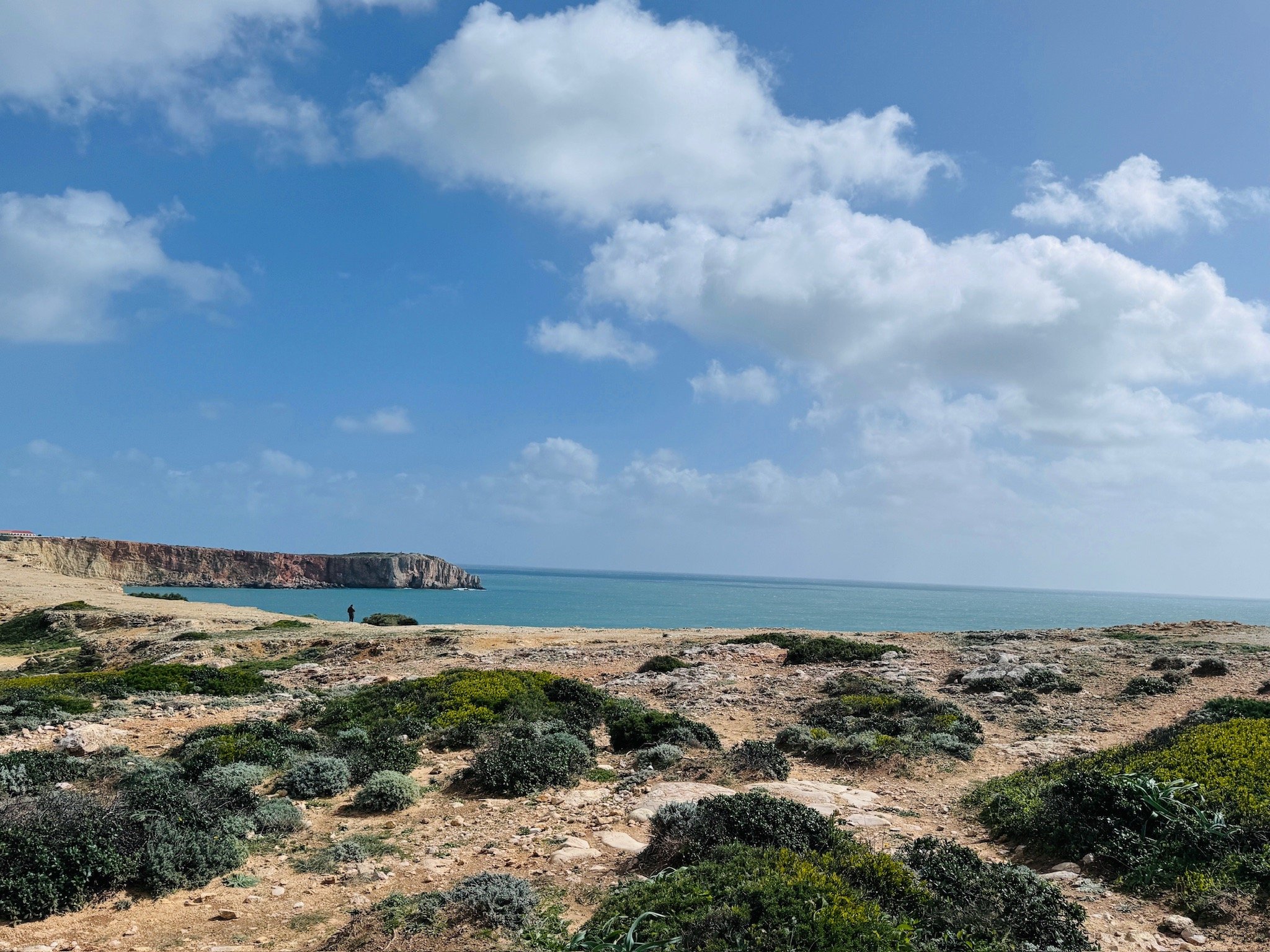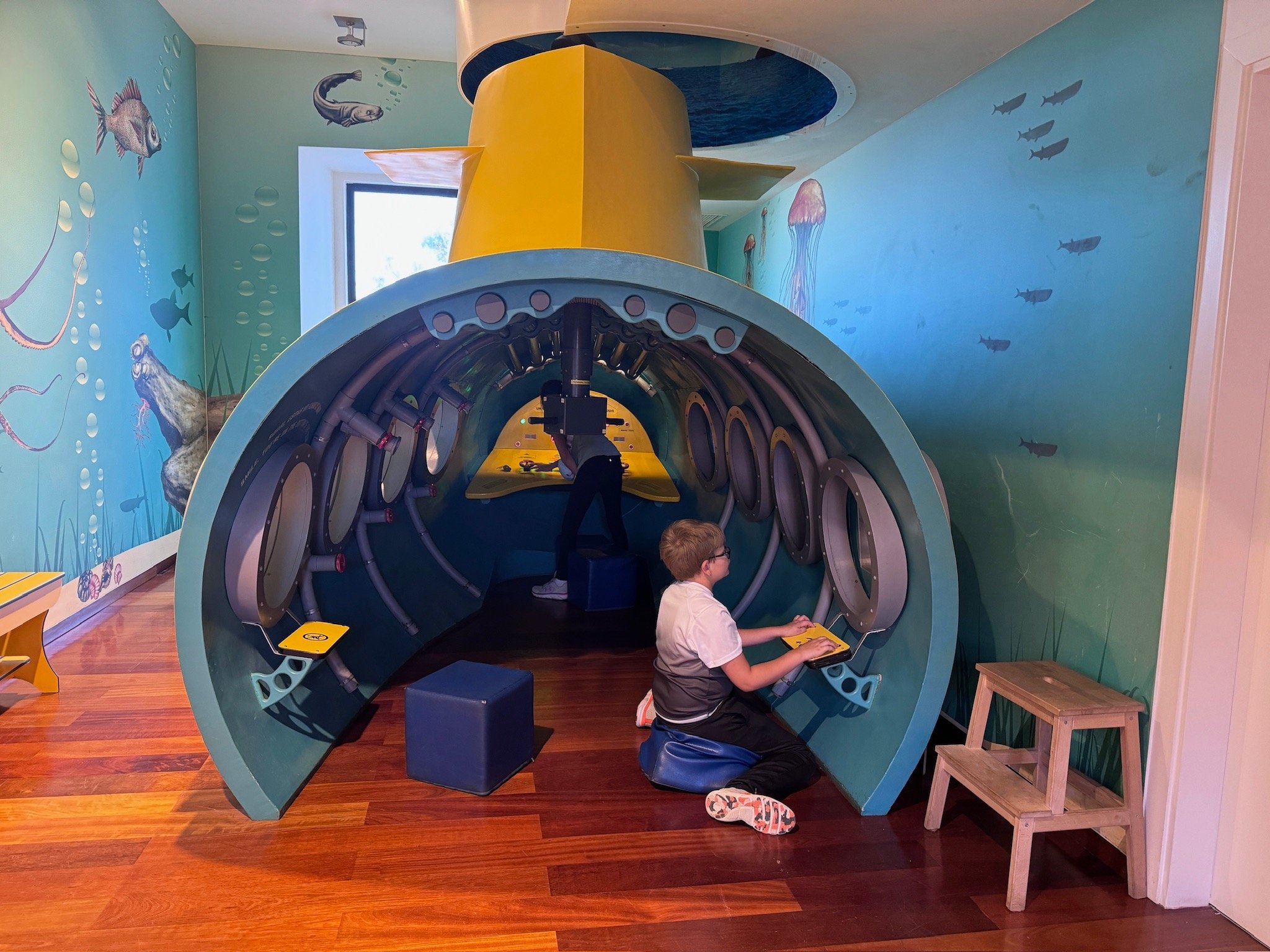Lagos, Portugal - Day 2

Tuesday, February 27, 2024
Good morning from Lagos, Portugal! Today we started our day with breakfast at Abigail’s Cafe in the Old Town of Lagos. Since Andi’s been so sick and the kids prefer to sleep late into the mornings if we’ll let them (they’ve been staying up until 10:30 or 11:00pm at night to talk to their friends back home), we haven’t been up and moving very early on this trip. Today, Andi and I decided to get an earlier start to our day by having breakfast at a cute cafe our airbnb host recommended.
It was still windy and cold in Lagos this morning, so we bundled up in our warmest sweatshirts and coats and made the 15-minute walk to the city centre. By the time we got there, our noses were running and we were in desperate need for something warm to drink! I don’t know why it feels so cold here (the air temperature was around 55 degrees F this morning); perhaps it’s because the wind hasn’t stopped blowing since we arrived to mainland Portugal. I honestly thought it was going to be warmer during our trip to southern Europe, and regret not bringing a warmer jacket and stocking hats for everyone. I see people walking around wearing shorts or no coats at all and wonder if they’re tougher than I am? Or, maybe they thought it was going to be warmer in southern Portugal, too.
The inside of Abigail’s Cafe, though, was warm and cozy. The host seated us at a low table in the center of the restaurant with long sofas on each side of the table. Andi and I ordered coffees, and Tory asked for a mocha. It came with a fancy milk drawing on top which absolutely delighted her.
I ate the best-tasting pastel de nata (egg custard tart famous in Portugal) that I’ve had so far on this trip! It was warm, so the custard oozed out of the crisp pastry shell and tasted of cinnamon. Andi also spoiled the kids with a brownie to share before our breakfast meals came to the table.
For once, I didn’t mind a restaurant meal stretching on for a while. The four of us played Kings in the Corner together and enjoyed the comfortable, inviting atmosphere. For his breakfast, Andi ordered a buddha bowl filled with roasted veggies, chickpeas, sweet potatoes, and hummus. I ordered eggs over toast with mushrooms, feta, and spinach. Tory and Aden enjoyed mini pancakes and fruit.
After breakfast, we walked across the courtyard to the Slave Market Museum located in the Antigo Mercado de Escravos plaza. In the 15th century, Prince Henry the Navigator became governor of the Algarve and settled in Lagos, Portugal. He wanted to expand trade by finding new sea routes to China, Asia, and Indonesia. At the time, only northern parts of Africa had been discovered. Portugal’s Henry the Navigator was the first explorer to venture down the western coast of Africa, opening the way to European exploration and maritime trade.
Years later, with further development in maps and navigation, a Portuguese explorer named Vasco da Gama was the first to make it all the way to India. At first, silk, spices, gold, ivory, and exotic animals were the traded goods, but eventually navigators realized that trading slaves could also be a profitable business (especially after Portugal established its “new world” colony in present-day Brazil). As a result, Lagos established the first African slave market in Europe which took place in the courtyard where the present-day Slave Museum is now located.
Of course, Andi and I remember bits and pieces of information we learned in school about the Age of Discovery, but there’s something so impactful about seeing those historical places in person. I’m sure I once learned about Portugal’s dominance of maritime trade and navigation in the 15th century, but until I stood for myself in the country of Portugal and visited museums highlighting the country’s maritime discoveries, it all felt like a page in the story of history. I hope that Tory and Aden walked away from our visit to the Slave Market Museum, and the maritime museum in Sagres yesterday, with a deeper understanding about these pivotal points of history.
I do wish the Slave Market Museum would have included more information about Portugal’s leadership in the Age of Discovery and the navigational advancements made at the time. The Slave Market Museum somewhat assumed its visitor had a base understanding, of which Tory and Aden did not. I had to explain a lot of the backstory for them to truly understand what was happening to the Africans who were taken from their communities, and the influence the city of Lagos played by its central geographical location.
The museum did have interactive iPads which gave further information and animated graphics about the exhibits. I sensed that the iPads were either a new addition to the museum, or they didn’t allow children to use them because the museum employee followed closely behind us (often with one eyebrow raised toward our children).
Our €5/pp ticket price to the Slave Market Museum also included admission to Lago’s main city museum called Museu Municipal Dr. José Formosinho. Getting inside this museum was a bit of a hubbub as a long line was cued at the entrance. Our family does not wait in lines well! Andi got our admission tickets stamped at the front desk while the kids and I held our place in line at the entrance gate. The museum only allowed a certain number of visitors at a time, and drinks and large bags were not permitted. Tory was appalled that a lady had to leave her big purse and water bottle behind the front desk.
To be honest, we didn’t find this museum to be all that fascinating. We saw collections of very old Moorish pottery, Portuguese coins, and old documents from the city. The most impressive room was the preserved Church of Santo Antonio which, except for a few parts with Portuguese azulejo tiles, is covered completely in gold leaf. The brightness of the gold made it hard for my eyes to be inside the room without squinting. It was pretty impressive! The walls were covered in tiny baby faces (or, cherubs) — so much detail. The closer I looked, the more dolls I saw — it was wild! I got Tory and Andi to start looking for them, too, and Andi said, “Now I can’t unsee them!”
After the museums, we wandered through the cobblestone streets Old Town. It’s clear that art and beauty are important in the Portuguese culture, showcased in its intricate designs and murals. There’s also lots of souvenir shops throughout Old Town selling handicrafts, postcards and cork purses. Portugal is the world’s largest cork producer (who knew!) with the vast majority of this product being made into wine bottle stoppers. Additionally, many shops in Portugal also sell handbags, wallets, shoes, and other products made from cork.
Andi wanted to check out the fresh food & fish market in Lagos called Mercado Municipal. This three-story market is open everyday selling fresh fruits, souvenirs like sardine tins and knick-knacks, and freshly-caught fish. There’s also a restaurant on the top floor. We visited in the early-afternoon, so the market was pretty quiet. A few vendors were still selling fresh fish and other non-perishable products.
Andi was tired and said he needed to rest, so the four of us took an Uber back to our airbnb apartment. While Andi laid down, Tory, Aden, and I did school work at the kitchen table. The kids and I reviewed what we’d learned at the Slave Market Museum, and they each journaled about it in their notebooks. We also did Math and Language Arts assignments. I always travel with a paper copy of a world map so I can show the kids where we are when we’re traveling. Today, it proved especially helpful as we talked about early navigation and trade routes during the Age of Discovery.
Around 4:00pm, Andi said he was feeling up to walking around again. We wanted to check out the iconic cliffs and rock formations along Lagos’ coastline.
Bengali Cave has become the most famous site to see along the coastline, thanks to internet and social media shares of the gorgeous, golden-colored cave formation. It’s only accessible by boat, however, and the weather wasn’t warm enough to interest us in doing that today. Instead, we walked from our apartment complex along a flat, well-maintained, wooden boardwalk that followed the coastline. The wind was brisk, but the views were breathtaking. There were plenty of spots to stop along the way, sit on a bench, and admire the sea and jagged rock formations.
The four of us walked for about three miles along the boardwalk, ending at a parking lot near the Sol Nascente Restaurant. Andi called an Uber which picked us up, and drove our family to Don Gull Restaurant located near the marina in Lagos. Unfortunately, we didn’t realize that it was only 5:15pm and the restaurant didn’t open until 6:30pm.
Andi suggested we walk along the marina sidewalk, but I was seriously frozen to the bone. That wind! The sun was starting to go down on the day losing the chance for any more warmth to be provided. Instead, we pivoted and went to the only restaurant we could find that was open called Vina Bar & Cozinha. The fact that we brought our kids to a wine bar, or perhaps that it was so early in the evening, was probably why the waiter gave us a strange look when we walked through the doors. In any case, he seated us inside the empty restaurant and provided us with menus. Andi and the kids ordered sodas, and I ordered a mint tea to drink. We also ordered a plate of french fries for our family to share and stayed there until the Don Gull Restaurant opened at 6:30pm.
The waiter at Don Gull Restaurant also greeted us with a quizzical look when we arrived as the doors opened for business. He asked if we had a reservation (which we did not), but seated us nonetheless at a table by the window. Our airbnb host said this is the best restaurant in Lagos, which was evident by how quickly the restaurant filled up with patrons.
There was a lot of fish on the menu and small, tapas-style plates to share. Andi and I ordered seared tuna, a beet salad, and a pork dish while Tory and Aden split the steak and french fries. The kids also shared slices of two very interesting desserts — triple dark chocolate cake with black vanilla ice cream, and white chocolate cake with cotton candy-flavored ice cream. They both raved about them, and Aden said it was the best dessert he’s eaten this whole trip.
The food was very good here, and our service was excellent. After we finished our meals, we took an Uber back to our airbnb apartment concluding our day in Lagos.
I rarely have the desire to visit a place twice, but Lagos, Portugal (and the Algarve, in general) is a place I want to come back to someday. I imagine that it’s incredible fun to sit outside on a cafe patio in the Old Town, or spend the day on the golden-colored sandy beaches, when the weather is warmer. The one benefit of visiting during the off-season is avoiding the crowds, which we’ve heard can be pretty intense during the summer months. It has been nice to wander the streets of town without a lot of people.
We have one more full day in Lagos tomorrow.




























